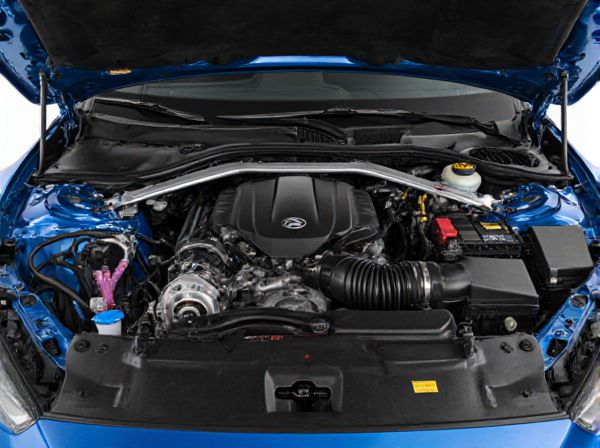
Photo illustration: Turbocharged vs Supercharged
Turbocharged engines use exhaust gases to spin a turbine, increasing air intake and boosting power with improved fuel efficiency. Supercharged engines rely on a belt-driven compressor connected to the crankshaft, delivering immediate power but often consuming more fuel. Understanding these differences helps you choose the performance upgrade that best suits your driving style and vehicle needs.
Table of Comparison
| Feature | Turbocharged Engine | Supercharged Engine |
|---|---|---|
| Power Source | Exhaust gas-driven turbine | Belt-driven compressor connected to the engine |
| Power Boost | High power increase, especially at higher RPM | Instant power delivery, effective at low RPM |
| Turbo Lag | Noticeable turbo lag due to spool time | No lag, immediate response |
| Fuel Efficiency | Improves fuel efficiency by recovering exhaust energy | Consumes more fuel as engine drives the compressor |
| Complexity & Maintenance | More complex, requires proper cooling and oiling | Mechanically simpler but adds direct engine load |
| Cost | Generally less expensive to produce | Usually higher manufacturing and maintenance costs |
| Common Use | Sports cars, turbo diesel engines, fuel efficiency focus | Muscle cars, drag racing, instant power applications |
Introduction: Understanding Forced Induction
Forced induction boosts engine power by increasing air intake pressure, enhancing combustion efficiency. Turbochargers use exhaust gases to spin a turbine, compressing air into the engine for improved horsepower and fuel efficiency. Superchargers rely on a belt-driven compressor connected to the engine crankshaft, delivering immediate power increase with minimal lag.
Turbocharging Explained
Turbocharging uses exhaust gases to spin a turbine, forcing more air into the combustion chamber and increasing engine power and efficiency. It improves fuel economy by recovering waste energy that would otherwise be lost in the exhaust system. Unlike superchargers, turbochargers rely on exhaust pressure, making them more energy-efficient and effective at higher engine speeds.
Supercharging Explained
Supercharging delivers instant engine power by forcing more air into the combustion chamber using a belt-driven compressor connected to the crankshaft, resulting in improved throttle response and low-end torque. Unlike turbochargers, which rely on exhaust gases and may experience lag, superchargers provide consistent boost across the RPM range. This direct mechanical drive makes superchargers popular for performance vehicles seeking immediate acceleration and enhanced power delivery.
Power Delivery Comparison
Turbocharged engines deliver power through exhaust-driven turbines, creating a boost that intensifies with engine speed, resulting in a variable but often higher peak power output. Supercharged engines use a belt-driven compressor that provides immediate and consistent power delivery across the RPM range, enhancing low-end torque and throttle response. Comparing both, turbochargers excel in maximizing peak horsepower and fuel efficiency, while superchargers offer superior responsiveness and smoother power delivery under rapid acceleration.
Efficiency and Fuel Consumption
Turbocharged engines generally offer higher efficiency and better fuel consumption compared to supercharged engines due to their use of exhaust gases to generate boost power without direct engine load. Superchargers, driven mechanically by the engine, tend to consume more fuel as they increase parasitic loss but provide immediate power response. For optimal fuel economy, turbocharged systems are preferred in modern vehicles, especially under steady cruising conditions.
Turbo Lag vs Instant Boost
Turbochargers generate power by utilizing exhaust gases, which causes a slight delay known as turbo lag before the boost kicks in, impacting immediate throttle response. Superchargers are mechanically driven by the engine crankshaft, delivering instant boost without lag, resulting in immediate power increase at low RPMs. The choice between turbocharged and supercharged systems depends on the desired balance between responsiveness and peak power efficiency.
Installation and Maintenance Differences
Turbocharged engines require a more complex installation involving exhaust plumbing and intercoolers, demanding precise tuning to optimize performance. Supercharged systems are generally easier to install because they connect directly to the engine via a belt drive, resulting in a more straightforward setup with fewer supporting components. Maintenance for turbochargers often involves monitoring turbo lag and ensuring proper lubrication to prevent bearing wear, while superchargers typically need regular belt inspections and tension adjustments to maintain efficiency.
Cost Considerations
Turbocharged systems generally offer better fuel efficiency and lower initial costs due to their reliance on exhaust gases for power, making them more cost-effective for everyday drivers. Supercharged engines, while typically more expensive upfront and in maintenance, deliver immediate power without lag, justifying higher expenses for performance-focused vehicles. Long-term ownership costs favor turbochargers due to better fuel economy and fewer mechanical complexities compared to the belt-driven superchargers.
Performance Applications and Use Cases
Turbocharged engines excel in high-performance applications requiring improved fuel efficiency and power output at higher RPMs, commonly used in sports cars and racing vehicles. Supercharged engines deliver immediate power with minimal lag, making them ideal for low-end torque demands in muscle cars, off-road vehicles, and towing applications. Choosing between turbocharged and supercharged systems depends on the specific use case, where turbochargers favor sustained high-speed performance and superchargers cater to instant throttle response and heavy-load scenarios.
Which is Better: Turbocharged or Supercharged?
Turbocharged engines utilize exhaust gases to spin a turbine, increasing air intake efficiency and delivering better fuel economy and higher power output at high RPMs. Supercharged engines rely on a belt-driven compressor connected directly to the engine, providing immediate throttle response and stronger low-end torque without lag. For performance enthusiasts seeking rapid acceleration and low-end power, superchargers excel, while turbochargers are superior for maximizing fuel efficiency and high-end horsepower.
 caratoz.com
caratoz.com